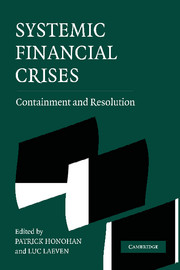Appendix: Banking Crisis Database
Published online by Cambridge University Press: 24 August 2009
Summary
This table presents data on episodes of bank insolvency that have occurred since the late 1970s. This database updates the work by Caprio and Klingebiel (1996, 1999) using various sources. It includes all countries that experienced banking crises for which information was available. There likely are countries not shown that had smaller crises since the late 1970s. As noted in Caprio and Klingebiel (1996), some judgment has gone into the compilation of this list, in particular in timing the episode of bank insolvency. The second column presents the crisis dates. The third column presents the lowest annual real GDP growth rate within the five-year period of the start of the crisis period, and the year that real GDP growth takes its minimum value. Column 4 presents the share of nonperforming loans at the peak of the crisis, and column 5 presents the share of insolvent banks in total banking assets at the peak of the crisis, when available. Column 6 presents estimates of the fiscal costs of the crisis, when available. These figures are mainly drawn from Honohan and Klingebiel (2003) and are consensus numbers. Column 7 presents output losses, when available. Estimates of the output losses of banking crises are sensitive to several assumptions, not least of which are the problem of dating crises and the difficulty in constructing a counterfactual for the growth path had there been no crisis. For more discussion of these problems, see Hoggarth, Reis, and Saporta (2002), and Honohan (2002).
- Type
- Chapter
- Information
- Systemic Financial CrisesContainment and Resolution, pp. 307 - 340Publisher: Cambridge University PressPrint publication year: 2005
- 88
- Cited by



